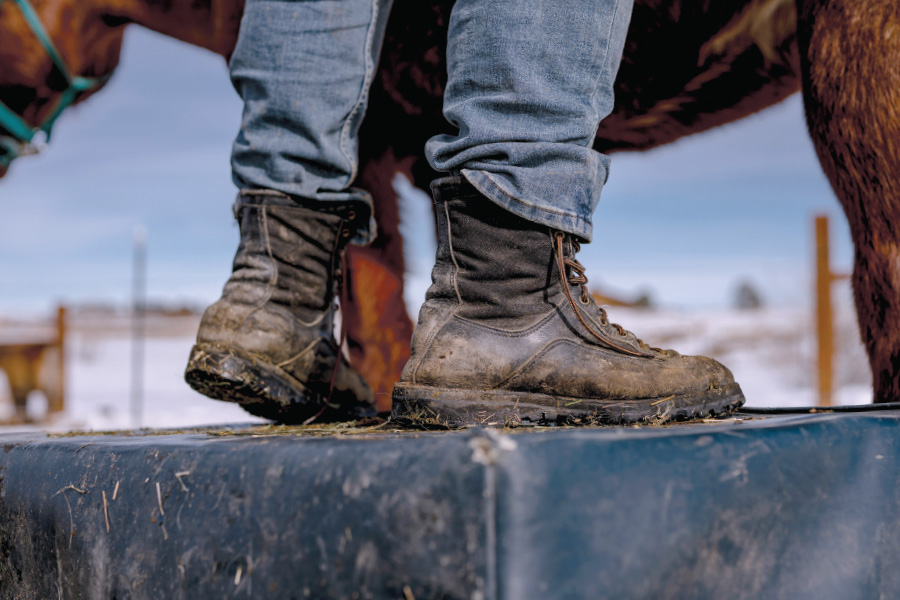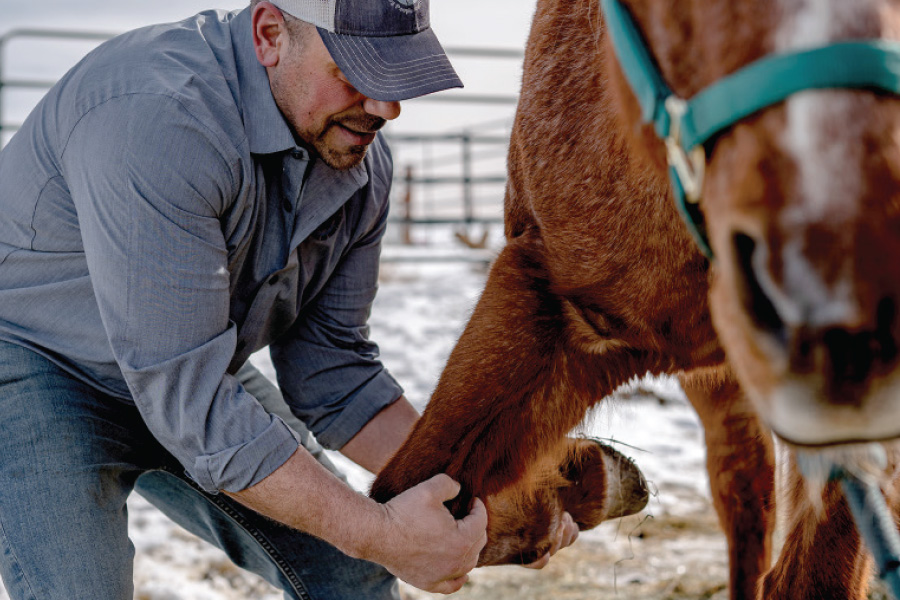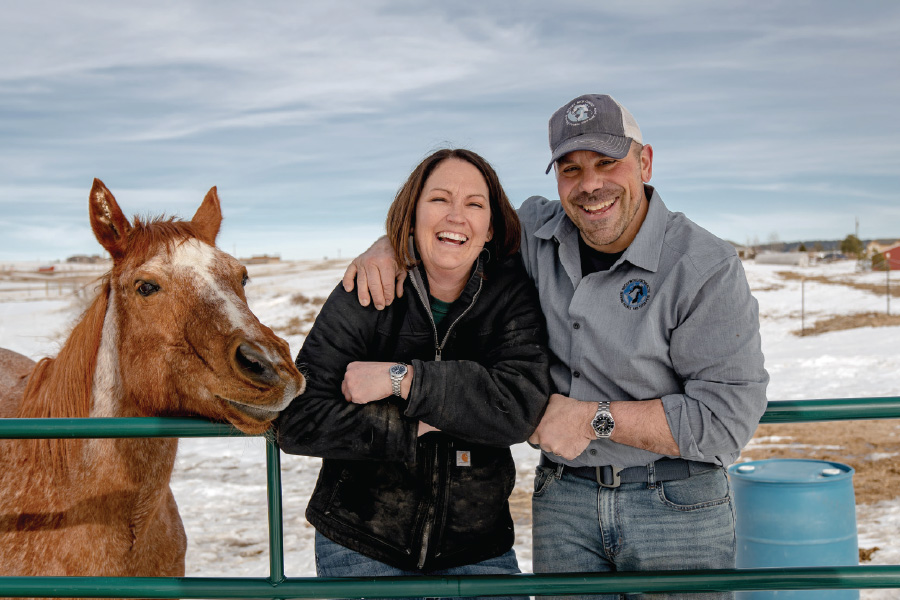CREATURES OF THE UNIVERSE
Dr. Vincent Loparco is an animal chiropractor. You read that correctly. He gives animals chiropractic adjustments. If you didn’t realize that was a thing, you’re not alone. In fact, when Dr. Vin started out back in 1998, it was almost unheard of.
“When I graduated chiropractic school, I had taken a hundred-hour certification for adjusting small animals. Back then, there was really no big animal chiropractic thing. But this lady from Australia was over here teaching at our school, and she did this certification so we could knowledgeably adjust dogs and cats.”

That was his introduction to the subject. He started working on small animals while waiting for his medical boards.
“I had a dog at the time, so I thought, this is great, I can practice on my dog. And a friend of mine had a cat. And I tried to adjust the cat. And it did not go well. The cat tore me up.”
At the time, adjusting animals was new and relatively rare, so Dr. Vin faced some challenges. The laws changed so that he could not adjust animals and charge for it. So, he did the work pro bono, on the side of his regular practice. Then, the laws changed again. Now, a vet needed to be present to do any kind of chiropractic work on animals. The logistics of that turned out to be untenable.
“So, that was kind of when I stepped out of it,” Dr. Vin admits. “And then my oldest daughter, Carly, started taking riding lessons.”
They got a horse for Carly, named Karly Juliette, and boarded Juliette at their friend’s ranch.
“Around this time, my wife, Jenna, was battling ovarian cancer, and one night she said to me, “Vin, I want to fulfill my dream. And my dream is I want to have a ranch with horses.”
Dr. Loparco is a former marine of Italian descent, and built like a tank. His whole demeanor gives you the sense that if something needs to be done, he will get it done, no matter what it takes. He brought that attitude to his wife’s dream.

“We sold our house on the West side and bought a house in Black Forest. I built a barn with my dad, father-in-law, and brother-in-law, fenced in everything and started building on Memorial Day Weekend. After work every day, I’d go home, and we’d do a little bit more on the barn. Then we got the barn done and started on the pastures. And then we were doing the fences. And then on Labor Day Weekend, we finally finished and we brought the horse home.”
Less than a year later, in June of 2013, Dr. Vin and his family faced the devastation of the Black Forest Fire as it swept all around them.
“I remember I told all the firefighters, I said, ‘Listen, you let my house burn. Save my barn. I just spent most of this last year working on this barn, and I’m not about to lose that.’”
He laughs. “That was almost my marriage right there, dealing with my father and father-in-law.”
They (and the house and barn and horses) survived the fire. But a few months later, they faced a new challenge. “So, we got Juliette home and got another horse to partner with her. And then Juliette slipped on the ice that winter.”
They called the vet out and gave the horse some pain management. “She had a big, swollen SI joint, probably a sprain or strain, and the vet gave us the name of a different vet who could do chiropractic and said we should look into having some acupuncture or chiropractic done. And that’s when my ears kinda perked up.”

At that point, 14 years after that initial hundred-hour course on adjusting small animals, there were four dedicated animal chiropractic schools in the United States. Of the four schools, Dr. Vin chose the only one run by vets because he felt that would give him the most well-rounded perspective. The school is called ACES and operates out of Meridian, Texas. He now has his license to practice on animals and has integrated that into his everyday practice.
“Is treating animals very different from treating people?” I asked.
“Treating animals vs. people... it’s so similar,” he said. “It’s almost identical. But I think it’s almost easier to treat animals because it’s so honest.”
“Honest, how?” I asked.
“They don’t compensate,” he explained. “And they’re not on drugs or NSAIDs. Most horses and dogs are not living a pharmacological life.”
“Do pharmaceuticals affect people when you’re trying to adjust them?”
“Absolutely! Your nervous system is constantly taking in information from the environment and processing and spitting out a response. That’s your nervous system’s job, to keep you in homeostasis, to keep you in existence, and to balance that existence. And when you take medications–and I understand that it’s sometimes important to take medications because sometimes your body can’t self-regulate and needs help. But does that heal the individual, or are we just masking symptoms until, eventually, something bigger presents itself? It would be like driving down the road, and your check engine light goes on, and you go, ‘you know what, I’m going to just put a piece of black electrical tape over that, so I don’t see it’ and then eventually smoke starts coming out. These are signs and symptoms that something bigger is happening, and if you keep going, you will eventually have a bigger problem. It’s not just about neck pain or back pain; it’s about your whole body working together. If I’m going to adjust your spinal column, it’s going to impact your spinal cord, which is part of your Central Nervious System. And with animals, because they are not on all this stuff, routinely you get quicker, more” honest physiological feedback.Then he told me the following story about the digestive woes of a sloth called Bart.

“We were in Arizona for a vacation, and my wife booked a trip to Out of Africa, which is an animal preserve. And they’re all African creatures. And so they’re out there on this huge property and there are lions, hyenas, gazelles, and whatnot. There are giraffes and emus and ostriches and all that stuff. We got there, and my wife booked us to feed and pet the sloth exhibit. My middle daughter really wanted to experience the sloth; she was really into sloths at the time.
Our appointment was at 8am. And so we get there, and there’s a sign on the entrance of the exhibit that says it was closed because the sloth, whose name was Bart, was sick. And I happened to notice someone was in there, so I knocked on the window. I looked back, and my family was slowly moving away from me, like, ‘Dad, you’re so embarrassing, stop, stop!’ But the handler opens the door, and she’s like, “we’re closed,” and I said, “yeah, I know, what’s going on?” And she’s like, “uh, we’re closed; the sloth isn’t feeling well,” and I said, “well, what’s wrong with him?” and she said, “who are you?”
So I said, “I’m an Animal Chiropractor, and I’m just curious if I can help out in any way.” And so the lady told me that with sloths, it takes about two weeks for them to go to the bathroom. Bart hadn’t gone in about 4.5 weeks. He was backed up. He wasn’t eating. He was really sick. So I asked if I could adjust him, and she told me she was just the handler, and she’d need to call the zoo vet. I ended up talking to the vet, and she asked where I went to school and all that. At one point, I asked her, “how many vertebrae does Bart have in his neck?” And she said, “what do you mean?” and I told her how sloths are the only mammals that can have more or fewer than seven cervicals. What’s fascinating is that a giraffe has seven cervicals, but look how long their neck is. And a monkey also has seven cervicals, but monkeys can be really, really tiny. If it’s a mammal, it’s going to have seven. Sloths are the only exception. They can have more or fewer than seven, depending on the animal. So, she looked it up, and Bart had five cervicals, and I think that was the green light, she thought: ‘he knows what he’s talking about.’ So she goes, “sure, you can adjust him.”

So now my family has moved back behind me, and they’re like, ‘Dad’s going in!’ So the handler and I climbed the ladder, and Bart was upside down in the tree, so I asked the handler to support his spine, and I started to check his neck. And I was feeling around, and I felt that his atlas (the small bone at the base of the skull) was way out of place. So I gave him a little neck adjustment. His eyes got really, really big. Then he reached really slow and moved himself up a little bit, and so I was like, “Okay, let’s leave it at that. That was huge.” So we left and went to the next exhibit.
About an hour later, a little zoo golf cart with a couple people on it pulled up and yelled over to me and my family. And they were like, “Hey! Bart came down and pooped!” And I was like, “Oh my god!” And they were like, “Whatever you did, it worked! This is the coolest thing!”
Dr. Vin’s face lights up with a big smile. “That’s chiropractic,” he says. “That’s what it is. Removing the interference to the nervous system and just letting the body do its thing.”
The conversation turned back to horses. Dr. Vin told me that vets often see cases of colic in horses, where the horse is lost because the colic can’t be resolved.
“And colic is when the intestine twists, right?” I asked.
“There are so many different types of colic with horses,” Dr. Vin explained. “We use the term ‘colic’ very generically. It could be a twisting colic or an impact colic, where a horse doesn’t drink water and eats a bunch of hay, and it’s dry, and it gets stuck and impacted in the bowel. It could be a sand colic. But once a horse has colic, you’ve got a short window. Otherwise, you’re gonna have to put the horse down. But if you know some techniques that can stimulate the Parasympathetic Nervous System, which affects the bowels, and can relax the horse and naturally cause a peristaltic contraction through their intestines, why not try it, right? And, it works.”
“Have you seen horses saved from colic that way?”
“Yes! Yes, and not just my own. Numerous. I would say, in the double digits since I’ve been doing this.”
I told him about my mother’s horse, Simon, who had died from colic. I was only 8 at the time but I remember well how devastating it was for my mother to lose her beloved horse. I wish we had known about this technique at the time.
“Imagine all the horse owners out there if they had known that there was another option to help out. Not to replace what the vet is gonna do. But add another tool to your tool-belt before you make that decision to put the horse down.”
I asked him if he ever got back to working on cats after his problematic first experience. He sheepishly admits that he simply didn’t understand cats at the time. He was more of a dog person and didn’t realize that cats must be approached differently.
“I was approaching that cat like a dog, and I didn’t respect it, and it tore me up. I mean, literally, tore me up. Cats don’t like me, that’s what I thought. But I didn’t realize. Now I’m more of a cat person. My wife and kids wanted a cat for down at the barn, and we got one. I thought at first, ‘Oh man, not a cat!’ but this cat was so cool. Right after we adopted him, he got really sick. And I wrapped him up in a towel, and I was feeding him with the dropper and giving him his antibiotics, and I think that formed the bond because I was the one doing it. Dogs, you throw a piece of cheese or a bone, and they’re like, ‘Ohhh, you’re my best friend!’ Cats have to really bond and have that trust, but once you get it, they’re your best friend. He knew the sound of my truck, and no matter where he was down in the field or barn, he would run and meet me in the driveway. I would hit plastic golf balls, and he would retrieve them. He changed my perception of cats.”
As a cat lover, I could relate. “It’s amazing how emotional animals are,” I said.
He nods. “And how innately intact they are. They are part of the universe. They are creatures of this universe with us, and when you look at it like that, you go, gee, I wonder how this horse feels, or I wonder how a goat or a cat, or a fish feels. What is their experience? That’s what Animal Chiropractic has done for me. How do I connect with these animals in a non-threatening, co-existent, symbiotic relationship? How do I get them to feel better? I want them to know I’m here to help them and not hurt them.”


